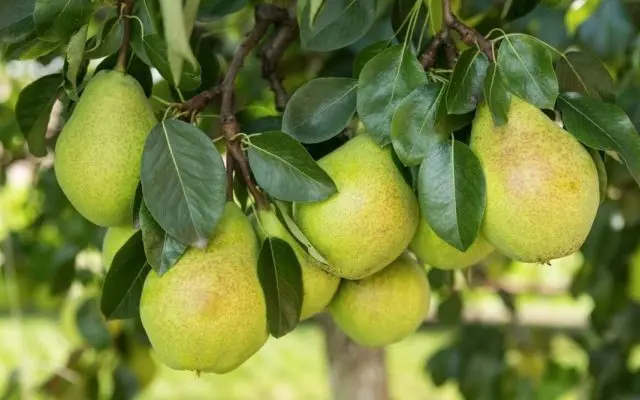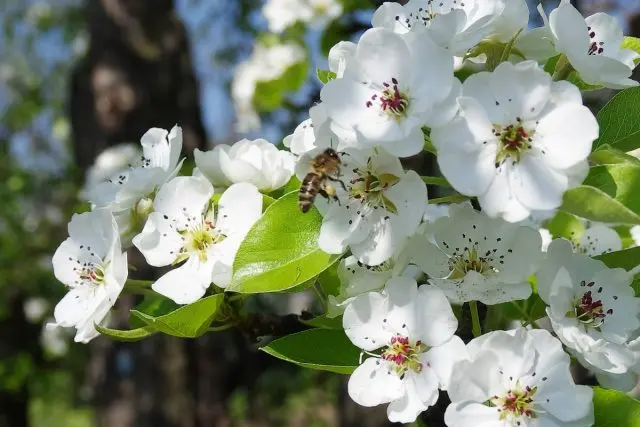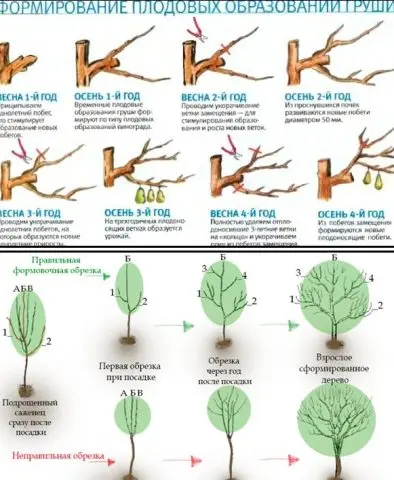Contents
In order not to wonder why the pear does not bear fruit if the age of fruiting has come, you need to learn everything about this crop before planting it in your summer cottage. There are many reasons for delaying the harvest, but all of them can be eliminated by agrotechnical methods.

At what age does a tree begin to bear fruit?
Some gardeners classify the pear as a capricious tree. Others do not see anything special in its cultivation and do not consider it picky. In order for a pear to give a rich harvest of juicy tasty fruits, you need to at least plant in your area the variety that was bred for this climatic region.
If the variety is southern, then it will be very difficult to get from it in the Northern region what it gives in the Southern region. In this case, the pear can be called capricious. For northern climatic conditions, it is necessary to select the appropriate varieties of pears, adapted for a cool short summer.
After planting a seedling, for the first 2-3 years it does not give an ovary and does not bear fruit. And that’s okay. A tree for later life strengthens its root system. If during these years it began to bloom, then the ovary must be removed so that the tree spends all its strength on growing and strengthening the roots.
It is considered normal among gardeners if the tree began to bloom and bear fruit for 4-6 years. There are pears that begin to bear fruit for 10-15 years. Of the most famous varieties, on average, in the region, by fruiting age, the following can be distinguished:
- after 3-4 years, the varieties Pamyati Yakovlev, Moskvichka begin to bear fruit;
- 4-5 years must pass after planting, so that you can taste the pear Patriotic, Larinskaya, Krasnobokaya;
- 5-6 years is needed for Leningrad and Beauty for the arrival of their age for flowering and fruiting;
- it will take about 10 years for the Josephine and Bereslutskaya varieties to mature, and only then will pears appear.
In any case, if the pear does not bloom 7 years after planting the seedling, you should think about it and try to find out the reason.
Why the pear does not bloom
The main reason for the absence of fruits on the tree is that the tree simply does not bloom, respectively, there are no ovaries and there will be no fruits. But the reasons why the pear does not bloom need to be clarified, since there are many of them.
Variety Features
The first thing they pay attention to when buying seedlings is after how many years flowering and fruiting begin in this pear variety. In different varieties, the fruits begin to ripen at different ages. There are trees, the harvest from which is expected for 15-20 years.
If a young pear turned out to be just like that and does not bear fruit due to its varietal characteristics, then you can graft a variety with a short fruiting age to the tree and get fruits earlier. Or, on the contrary, graft a pear to a quince, and it will bloom and bear fruit earlier.
For a long time Dichka does not bear fruit. Therefore, when buying a seedling, they carefully examine it, determine whether it is a wild bush or a varietal one. In a varietal pear, the trunk should not be smooth at the bottom. Slightly above the root neck there should be a grafting site, it is clearly visible.
Lack of sunlight
Probably, it would be more correct to attribute the pear to the southern crops, since its winter hardiness is low and it requires a lot of sunlight to ripen a rich crop. As gardeners note, the plant should receive at least 6 hours a day of direct sunlight. Planted in the shade or even partial shade, the pear will not bear fruit for 5 years or more until the branches grow up to receive enough sun.

Nutrient Deficiency
The composition of the soil in which a tree grows has a great influence on its condition and ability to produce a crop. Favorable soil is light, slightly moist soil with neutral acidity.
With a lack of nutrients, all processes in the tree slow down, it may not even bloom, and if it blooms, the ovaries will quickly fall off. Missing substances should be replenished.
You do not need to add a lot of nitrogenous dressings at once. Otherwise, the pear will grow strongly, grow, and will not bear fruit. Apply nitrogen fertilizers in the spring in such an amount that by about the middle of summer they are already used up.
For the ripening of flower buds, potash and phosphorus fertilizers will be useful. They need to feed the pear during the ripening of the fruit. Granular potassium-phosphorus additives are introduced to a depth of 20-25 cm in the near-stem circle and covered with earth.
Wrong fit
The ability to bloom and bear fruit can be affected by planting carried out without observing the necessary rules. During planting, special attention is paid to the location of the root collar – the place where the trunk goes into the roots. It should be level with the ground surface, not too deep or too high.
In the first case, if the planting is done recently, the whole pear is lifted with a shovel and soil is poured under the roots or the earth is raked from the trunk so that the root neck is higher. In the second case, soil is added along the trunk circle to cover the roots, and they do not freeze with the onset of cold weather.
You should also know that when planting, annual seedlings tolerate transplanting more easily, take root faster and enter the age when they begin to bloom and bear fruit. Two-year-olds get sick longer and the time for fruit ripening may come later than for planted one-year-olds.
Another important point that you should pay attention to when planting seedlings is their orientation to the cardinal points. In order for the seedling to feel more confident, it is planted the way it grew in the nursery: the southern side of the bush in the new place should again look south.
Incorrect trimming
A pear can have a dense crown, which will prevent it from fully blooming and bearing fruit. Therefore, pruning is done annually to thin it out. The branches extending from the trunk at an acute angle upwards are tilted to a horizontal position, fixed with a load or a loop. And those that grow inside the crown are removed. Such thinning should not be strong. Otherwise, a young pear will recover for a long time, will not bloom and bear fruit.
When pruning, you need to know which branches to remove. The pear bears fruit every year. In one year, some branches bear fruit, in another year they rest, and pears ripen on neighboring ones. Incorrectly done pruning can cause no harvest this year.

Pruning will not cause columnar pears if they are not fruiting, as this variety does not need pruning.
Freezing in winter
Many varieties of pear are not resistant to frost. If the snow has not yet fallen and covered the ground, and the frosts are already reaching -100With… -200C, then the roots of the tree may freeze slightly. This will cause the pear to stop blooming and, accordingly, bear fruit.
If severe frost is expected before snowfall, then, if possible, the roots are insulated for the winter with improvised means: they mulch the area around the trunk with a crown diameter, lay spruce branches, peat, and straw on top. The lower part of the trunk is wrapped with insulating building material, burlap, plastic.
There are cases when the bark cracks due to winter frosts or rodents eat it. With the advent of spring, before the start of sap flow, you need to cover up the wounds with garden pitch or clay and wrap it with a cloth.
Waterlogging of the roots
Close groundwater can make the soil so wet that the roots of the pear bush begin to get wet and rot. The pear will spend energy and nutrients to restore the normal functioning of the root system. As a result, it will bear little fruit, bloom slightly, the formation of ovaries will decrease or completely stop.
Groundwater can deplete the soil, washing out the minerals necessary for the pear. Therefore, you need to plant a crop in a loose, well-drained area.
Diseases and pests
Various insect pests and fungal diseases can prevent the pear from blooming and, accordingly, deprive it of its ability to bear fruit. With the advent of spring, an apple flower beetle can attack a pear, destroying its flowers. Pear sucker (leaf leaf) affects the kidneys and is a carrier of a fungal disease that can affect the entire tree. Actively feeds on the pulp of the fruits of the codling moth and other insects.
Therefore, even before the snow melts, it is recommended to impose adhesive belts on the trunk and, before flowering, carry out preventive spraying of trees with such preparations as:
- “Alatar”;
- “Kinmix”;
- “Ivanhoe”;
- karbofos and chlorophos.
How to stimulate pear blossom
The work of gardeners with fruit trees is aimed at obtaining a harvest. First of all, they create favorable conditions for the growth of the pear, its ability to flourish and bear fruit.
In addition, experts carry out some additional manipulations to stimulate the pear to bloom:
- regular thinning of the crown;
- bending branches to a horizontal position;
- cutting off the top of the trunk to stop upward growth.
If the pear bushes profusely, has all the favorable conditions for growth, but does not bear fruit or even does not bloom, then some gardeners suggest creating a stressful situation that would stimulate the pear to bloom and bear fruit. One such method is to drive a couple of nails into the trunk.
So that the outflow of nutrients does not go to the roots, a ring of bark up to 0,5-1 cm wide is removed on one of the branches. Then the wound is coated with garden pitch or bandaged with a film. It is believed that the movement of juices down the branch will slow down, and the pear will begin to bloom and bear fruit.
How to stimulate a pear is up to the gardener, but he must provide it with the necessary living conditions if he wants to get a good harvest.
Why the pear blossoms but does not bear fruit
Pear refers to non-self-fertile plants. If only one variety of pear grows in the garden, the reason that it does not bear fruit, although it blooms, is obvious. For pollination of flowers, at least one more pear variety is needed. This must be taken into account when buying a seedling and immediately purchase 2 different varieties for your garden.
Sometimes it happens that spring has already come, everything in the garden has blossomed, and then frosts have returned. It is very difficult to deal with return frosts that ruin the future crop.
What to do if a pear blossoms but does not bear fruit
In the spring, at a certain time, the pear begins to bloom magnificently, filling the garden with a pleasant aroma. But it may turn out that the long-awaited harvest was not expected from her. To prevent this from happening, you need to take measures in advance to help the fruit tree:
- If there is only one pear variety in the garden, then the reason for the fruit not ripening is the lack of pollination. It is recommended to plant another variety at a distance of 3-4 m. Their flowering time must match. Or graft a branch of another variety to the pear. Then the pollination of pear flowers will be ensured.
- In the spring, you should pay attention to the weather conditions. It may turn out that the early arrival of heat will provoke an early flowering of the pear. And then the cold will come again and destroy the fruit buds. Gardeners are trying to save flowering and smoke the tree. But this doesn’t always help.
These two reasons can deprive a pear of fruit if all other requirements of the fruit tree are met. Therefore, they must first be taken into account if the tree blooms, but does not bear fruit.
Preventive measures
Having decided one day to plant a pear on the site, you should create the conditions under which it will grow, bloom and delight with its delicious fruits. We list the necessary measures for the care of a pear:
- the right choice of soil without nearby groundwater;
- sufficient sunlight;
- absence of drafts and strong wind;
- timely watering and top dressing with fertilizers;
- pruning and shaping the crown according to the rules;
- the presence of a pollinator on the site;
- spraying against pests and fungal diseases;
- freezing prevention.
All these actions are normal and natural for growing a fruit tree and do not contain anything special that a novice amateur gardener may not be able to do.
Conclusion
The considered list of reasons why a pear does not bear fruit during its fruiting period and sometimes does not even bloom leads to the conclusion that the expected result can be obtained after observing the elementary rules of agricultural technology. Decisive for a pear tree is the correct choice of variety for a particular climatic region.









